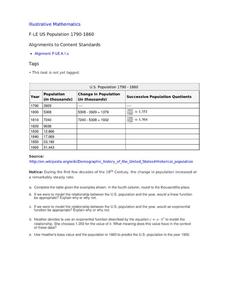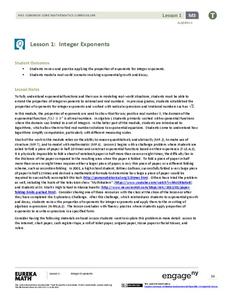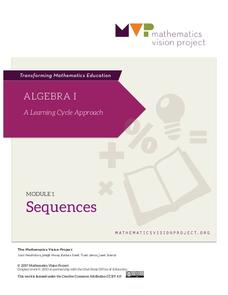Mathematics Vision Project
Module 6: Quadratic Functions
Linear, exponential, now it's time for quadratic patterns! Learners build on their skills of modeling patterns by analyzing situations with quadratic functions. The sixth module in the Algebra I series has pupils analyze multiple...
Curated OER
US Population 1790-1860
Your young population scientists analyze a table of values, write a model to represent the real life data, finish the table of data and predict future populations in a collaborative, real-life activity.
EngageNY
Writing and Evaluating Expressions—Exponents
Bring your young mathematicians into the fold. Scholars conduct an activity folding paper to see the relationship between the number of folds and the number of resulting layers in the 23rd installment of a 36-part module. The results of...
Illustrative Mathematics
Modeling London's Population
Looking at London's population from 1801–1961 in 20 year increments, high school mathematicians determine if the data can be modeled by a given logistic growth equation. They explain their thinking and determine the values of each...
Curated OER
Exponential Growth - Contagious
Students participate in simulating a flu epidemic. They debrief with a lecture about the ease with which diseases are spread.
Curated OER
Growth and Decay
In this algebra worksheet, students investigate growth and decay. They analyze the population of Winchester, Virginia to see what year had the most or least growth or decay. There are 4 word problems.
Curated OER
Population Biology
In this population worksheet, students complete a word search puzzle by finding the 17 terms associated with population biology.
Curated OER
The Mister Runtles' Bet
Students listen to a story dealing with exponential and linear growth. After reading the story, students complete a table comparing information. Using a calculator, students graph the rice and daily population of flies. They study the...
EngageNY
Integer Exponents
Fold, fold, and fold some more. In the first installment of a 35-part module, young mathematicians fold a piece of paper in half until it can not be folded any more. They use the results of this activity to develop functions for the area...
CCSS Math Activities
Smarter Balanced Sample Items: High School Math – Target E
Pupils rewrite expressions in equivalent forms to identify key features. They use the vertex and factored forms of quadratic expressions to identify the extrema and intercepts. To finish the installment of the Claim 1 Item Slide Show...
CCSS Math Activities
Smarter Balanced Sample Items: High School Math – Target M
Your knowledge of graphs is a function of how much you try. Young mathematicians work on a set of 12 questions that covers graphing functions, comparing functions, and rewriting functions in different forms to determine key features....
Mathematics Vision Project
Module 1: Sequences
Sequences are all about recognizing patterns. A module of 11 lessons builds pupils' understanding of sequences through pattern analysis. The practice connects the analysis to linear and exponential equations. This is the first module in...
Curated OER
Will Exams Be Cancelled?
If the flu outbreak continues, exams will have to be canceled. Investigate the properties of exponential and logarithmic functions. For this algebra lesson, students use the TI to examine and differentiate between exponential growth and...
Curated OER
Advising China
Students express their opinions about how growth and modernization affect nations. Reading an article on China, they discuss the causes and effects of exponential growth in a single town. They research how China has changed by writing...
Curated OER
How Many Is Too Many?
Students explore the population explosion. They view a video depicting the exponential growth of human population. Students research the internet to project future population data. They perform hands-on, multimedia activities to study...
Curated OER
Investigating the Method by Which the Body Defends Against Pathogens
High schoolers explore disease caused by bacteria and viruses, how they are transmitted, and how they exert their effects on their hosts. They explain how diseases, such as AIDS, are spread by exponential growth.
Curated OER
Precalculus: Unit 3 Test 2
In this Pre-calculus worksheet, students solve advanced logarithmic and exponential equations. The seven page worksheet contains thirty-two problems. Answers are not provided.
Concord Consortium
Rule of 72
Find an easier way to double it. Using the price of an item and the Consumer Price Index, learners determine how long it will be for the price to double. Scholars calculate the length of time it would take for the price to double using a...
Macquarie University
Logarithms and Exponentials
Introduce logarithmic functions and their properties with a straightforward lesson plan. It provides an introduction to new material, examples, and practice problems. The variety of problem types keeps learners engaged while...
Rice University
Calculus Volume 1
Differentiate between calculus concepts. The beginning of a helpful calculus resource begins with a short review of functions and moves right into limits to define derivatives. The six-chapter resource continues with applications of...
Curated OER
Introduction to Graphical Representation of Data Sets in Connection to Cellular Growth
Learners practice graphing relationships between variables by studying topics such as exponential growth and decay. They conduct a series of numerical experiments using a computer model and a variety of physical experiments using mold,...
Curated OER
Math 155 - Worksheet 10. Logarithm
In this logarithm worksheet, students read story problems, write an equation to solve the problem, and leave the answer in logarithm or exponential form. They find the derivative of given functions. This two-page worksheet contains six...
Curated OER
The Smelly Sandwich Case
In this exponential function worksheet, learners theorize the growth rate of bacteria found on a sandwich hidden in a student's locker. There are 6 questions to answer to solve the mystery.
Curated OER
Population Patterns
Students study patterns of population growth in an ecosystem and why populations must remain in balance. They interpret basic population graphs and suggest scenarios about different population growth patterns in an ecosystem.
Other popular searches
- Exponential Growth and Decay
- Exponential Growth Problems
- Algebra Exponential Growth
- Calculating Exponential Growth
- Exponential Growth Functions
- Exponential Growth and Deay
- Exponential Growth and Aids
- Exponential Growth Skeeters
- Exponential Growth and Hiv
- Exponential Growth and Dea
- Exponential Growth Graph
- Exponential Growth Factor























